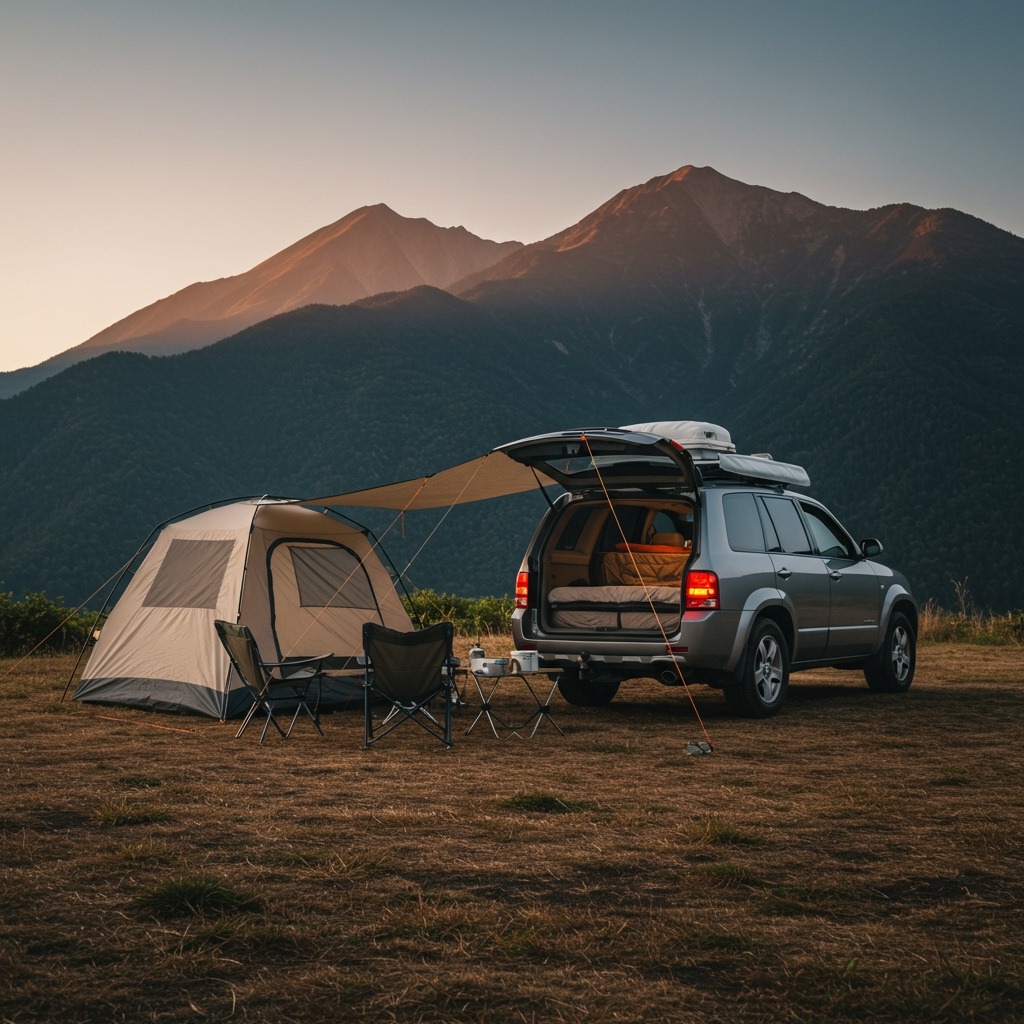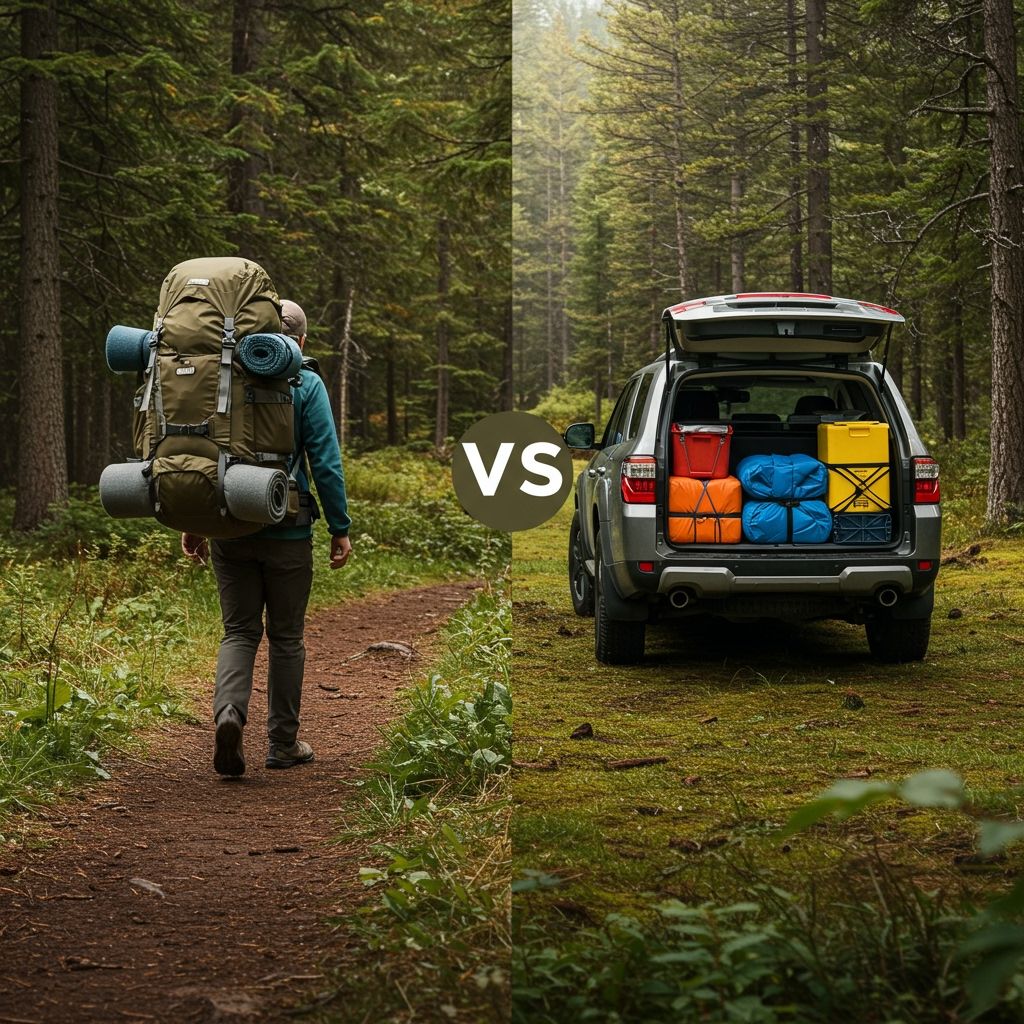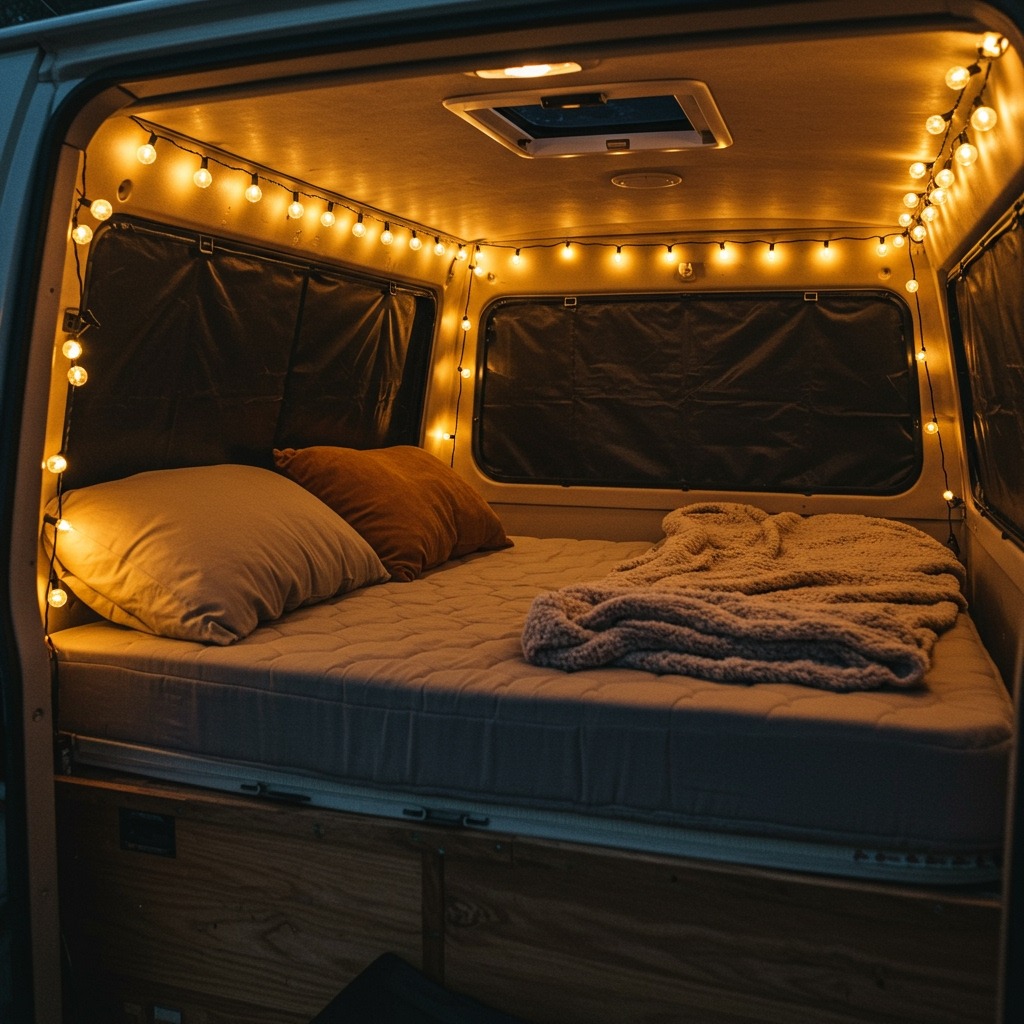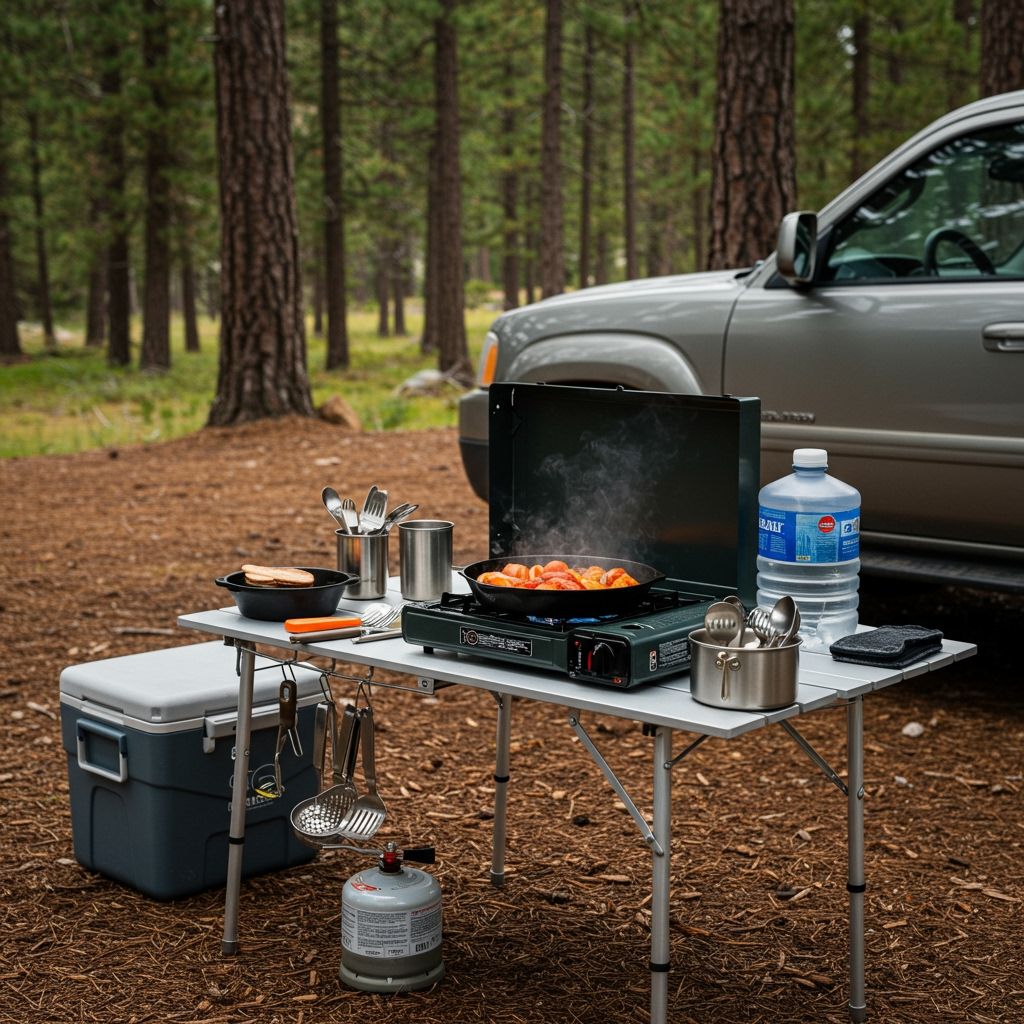Tired of feeling confined at traditional campsites? Dreaming of spontaneous adventures without the hassle of a bulky tent? Imagine waking up to a breathtaking view, right outside your mobile bedroom. If this sounds like your kind of escape, then car camping is your ticket to freedom. It’s the perfect blend of outdoor immersion and creature comforts, offering more flexibility and gear capacity than backpacking, while still keeping you connected to nature.
A successful car camping setup transforms your vehicle into a cozy, functional base camp, allowing you to explore more, stay longer, and enjoy the wild with ease. It’s about maximizing your space, organizing your essentials, and tailoring your ride to your adventure style. Whether you’re a seasoned outdoors enthusiast or just looking for a weekend escape, dialing in your car camping game will elevate your experience.
This guide will walk you through everything you need to know about setting up for the ultimate car camping adventure. We’ll cover essential gear, smart packing strategies, and how to optimize your specific vehicle for comfort and convenience. Get ready to hit the road and experience the wilderness like never before!

Why Car Camping? Comfort Meets Convenience
Car camping isn’t just about sleeping in your car; it’s a versatile and accessible way to enjoy the outdoors. It blends the best aspects of traditional camping with the unparalleled convenience of having your vehicle as a mobile base.
Accessibility: Get Closer to Nature Without the Heavy Backpacking
Unlike backpacking, where every ounce counts and long treks are required, car camping allows you to reach stunning natural areas without carrying heavy loads on your back. You can drive right up to your chosen spot, or at least very close to it, meaning less physical strain and more time enjoying the scenery. This makes it a fantastic option for families, beginners, or anyone who prefers to skip the strenuous hikes.
Gear Capacity: Bring More Comfort Items Than Backpacking Allows
This is where car camping truly shines. Your vehicle acts as a giant gear locker, freeing you from the strict weight and space limitations of backpacking. Want to bring a comfortable air mattress, a full kitchen setup, or even a portable projector for outdoor movie nights? With a car, you can! This increased capacity means you can enhance your comfort level significantly, bringing those little luxuries that make your outdoor experience truly enjoyable. Think about upgrading your camping clothes for maximum comfort, rather than just utility.
Flexibility: Spontaneous Trips, Easy Pack-Up and Move
Car camping offers unmatched flexibility. You can decide on a whim to head out for a weekend, knowing you can pack quickly. If the weather changes or your plans shift, packing up and moving to a new location is a breeze. This adaptability is perfect for those who love spontaneous road trips and exploring multiple destinations.
Budget-Friendly: Often More Affordable Than Other Travel
Compared to hotels, cabins, or even extensive backpacking gear investments, car camping can be incredibly cost-effective. Your primary accommodation is your vehicle, and cooking your own meals saves significantly on dining out. This makes it an ideal way to explore national parks, forests, and remote areas without breaking the bank.

Essential Car Camping Setup Components
Building your ideal car camping setup revolves around a few key areas: where you’ll sleep, how you’ll eat, how you’ll power your devices, and how you’ll stay comfortable and safe.
The Sleeping System: Your Mobile Bedroom
Your sleeping arrangement is the core of a comfortable car camping experience. You have a few options:
- Sleeping inside your car:
- Pros: Ultimate protection from elements, animals, and privacy. No tent setup/teardown.
- Cons: Can be cramped, requires leveling the vehicle, condensation can be an issue.
- Tips for Comfort:
- Leveling: Park on as flat ground as possible. If uneven, use leveling blocks under tires.
- Window Covers: Blackout fabric, reflectix, or custom-fit magnetic covers provide privacy and block light. They also help regulate temperature.
- Ventilation: Crucial for airflow and to prevent condensation. Window screens, battery-powered fans, or cracked windows (with rain guards) are essential. Learn how to stay cool while camping for warmer nights.
- Tent camping next to your car:
- Benefits: More space, stand-up height, separate living area.
- Tent Types:
- Car-attached tents: These connect directly to your SUV or hatchback, extending your living space from the vehicle. They often offer a large vestibule.
- Standalone tents: A traditional tent set up independently. Gives you the flexibility to drive away from camp if needed. Choosing the right tent is essential, consider our camping for beginners guide for more insights.
- Sleeping pads, air mattresses, sleeping bags/quilts, pillows:
- Sleeping pads: Essential for insulation and comfort, even if you’re in a car. Self-inflating pads offer a good balance of comfort and packability.
- Air mattresses: Offer superior comfort, especially for sleeping inside your car. Make sure you have a pump.
- Sleeping bags/quilts: Choose based on expected temperatures. A bag rated for colder temperatures than you anticipate is always a safe bet.
- Pillows: Don’t forget your pillow! A comfortable pillow makes a huge difference.
- Ensuring warmth and comfort: Consider an extra blanket or quilt, especially for chilly nights. Even in summer, temperatures can drop significantly. Dressing in layers is always a smart move. For tips on battling the cold, read about how to stay warm while camping.
The Kitchen Setup: Culinary Adventures on Wheels
Eating well transforms a trip from good to great. Your car camping kitchen can be as simple or elaborate as you like.
- Portable stove options:
- Propane stoves: Common, reliable, and powerful. Two-burner models are popular.
- Butane stoves: Compact and lightweight, great for single-burner needs.
- External Link: For a real rustic experience, you might even consider how to make cowboy coffee over an open fire.
- Cookware, utensils, plates/bowls: Bring lightweight, durable options. A cast iron skillet is excellent for camp cooking. Don’t forget a cutting board, knife, and a can opener.
- Cooler selection and ice management:
- Cooler Type: A good cooler is an investment. Rotomolded coolers offer superior ice retention.
- Ice Strategy: Pre-chill your cooler. Use block ice for longer retention. Consider using frozen water bottles – they double as drinking water as they melt. Learn how to pack a cooler for camping effectively.
- Water storage and purification: Bring plenty of water. Large water jugs are convenient. For extended trips or remote locations, a water filter or purification tablets are essential.
- Food storage and meal planning ideas:
- Storage: Use airtight containers to protect food from pests.
- Meal Planning: Plan simple, easy-to-prepare meals. One-pot dishes are excellent. Check out these easy camping meals for family.
Lighting & Power: Illuminating Your Campsite
When the sun goes down, good lighting and reliable power are game-changers.
- Headlamps vs. lanterns:
- Headlamps: Essential for hands-free tasks.
- Lanterns: Provide ambient light for your cooking area or inside the car. Battery-powered LED lanterns are bright and safe.
- Portable power stations/jump starters: These multi-functional devices can charge phones, power lights, and even jump-start your car. A must-have for peace of mind.
- Solar panels (optional): If you’re staying in one spot for an extended period, small portable solar panels can keep your power station topped up.
Shelter & Seating: Beyond Your Car
Extend your living space beyond your vehicle for ultimate comfort.
- Camp chairs and table: A comfortable chair is non-negotiable for relaxing. A small folding table provides a stable surface for cooking or eating.
- Awning or tarp for shade/rain: An inexpensive tarp or a dedicated car awning creates a shaded, protected area next to your vehicle, perfect for cooking or lounging in any weather.
Safety & Navigation: Stay Prepared
Even with the convenience of a car, safety in the outdoors is paramount.
- First-aid kit: A comprehensive kit for minor injuries and emergencies is vital.
- Navigation tools: Always carry a physical map and compass, and know how to use them. Don’t rely solely on your phone. You can even learn how to read a topographic map for deeper understanding.
- Fire extinguisher, multi-tool: Essential for safety and quick fixes.
- Emergency essentials: Jumper cables, tire repair kit, extra fuel (if venturing remotely).
Personal & Comfort Items
Don’t forget the small things that make a big difference.
- Clothing considerations: Pack layers suitable for varying temperatures. Even summer nights can be cool.
- Toiletries, towel: Keep a separate small bag for your personal hygiene items.
- Entertainment: Books, cards, camping games – bring what makes you happy in downtime.

Smart Packing & Organization Tips for Your Car Camping Setup
The key to a stress-free car camping setup is smart packing. Disorganization leads to frustration.
Categorize and Containerize: Use Bins and Bags
Invest in clear, stackable plastic bins. Dedicate one for kitchen items, another for sleeping gear, and so on. This makes it easy to find what you need without rummaging through everything. Duffle bags or collapsible crates also work well for soft goods.
Load Strategically: Access Frequently Used Items Easily
Think about what you’ll need first or most often. Place cooking gear and immediate camp setup items (chairs, table) where they’re easily accessible. Pack sleeping bags and clothes deeper if you’re only accessing them at night. This prevents you from unpacking your entire car just to get your coffee maker.
Maximize Space: Rooftop Cargo Boxes, Seat Organizers
If your car is packed to the brim, consider external storage. Rooftop cargo boxes are excellent for bulky items like sleeping bags or tents. Seat-back organizers or cargo nets can help keep smaller items tidy and within reach.
“Leave No Trace” Principles
Always practice Leave No Trace principles. Pack out everything you pack in, including all trash and food scraps. Leave your campsite cleaner than you found it. This respects nature and ensures others can enjoy it too.
Optimizing Your Specific Car for Camping
Your vehicle type plays a big role in your car camping setup. Different cars offer different advantages.
Sedans & Hatchbacks: Making the Most of Limited Space
Don’t underestimate smaller cars!
- Rear Seat Folding: Maximize space by folding down rear seats. Consider removing the rear seats entirely for extended trips if your vehicle allows and you’re comfortable doing so.
- Platform Builds: Even in sedans, minimalist platforms can be built over folded seats to create a flatter sleeping surface.
- External Storage: Rooftop bags or hitch-mounted cargo carriers become invaluable for extra gear.
SUVs & Wagons: Rear Sleeping Platforms, Cargo Management
These vehicles are often ideal for car camping due to their spacious rear.
- Rear Sleeping Platforms: Many DIY and commercial solutions exist for building a flat, elevated sleeping platform in the back, often with storage underneath. This keeps you off the cold ground and provides excellent organization.
- Cargo Management Systems: Use cargo nets, dividers, and custom inserts to keep gear from shifting around during transit.
Vans & Trucks: Built-in Conversions, Truck Bed Tents
- Vans: The ultimate blank canvas for car camping. Full conversions with built-in beds, kitchens, and storage are popular. Even a simple mattress in the back of a cargo van works wonders.
- Trucks: Truck bed camping offers incredible versatility.
- Truck Bed Tents: These pop-up tents fit directly into your truck bed, providing an elevated, comfortable sleeping area.
- Cabs/Shells: A truck cap or shell creates a weather-protected sleeping and storage area.
Ventilation Strategies: Window Screens, Rain Guards
Regardless of your vehicle, proper ventilation is critical.
- Window Screens: Custom-fit magnetic window screens keep bugs out while allowing airflow.
- Rain Guards/Window Visors: Allow you to crack your windows even in rain, crucial for reducing condensation.
- Battery-Powered Fans: Circulate air inside, especially on warm nights.
Pre-Trip Planning for a Seamless Setup
A little planning goes a long way in ensuring your car camping setup is ready for action.
Researching Campsites and Regulations
Before you go, know where you’re going.
- Campsite Availability: Book in advance if possible, especially for popular areas or peak season.
- Regulations: Check for fire restrictions, bear canister requirements, and waste disposal rules. Some areas allow primitive camping which offers a different experience.
Checking Weather Forecasts
Always check the weather for your destination. This dictates your clothing choices, sleeping gear, and overall setup adjustments. Be prepared for unexpected shifts.
Testing Your Gear at Home
Don’t wait until you’re at the campsite to discover your air mattress has a leak or your stove won’t light. Test everything at home. This is especially important for new gear.
Planning Meals and Packing a Cooler Strategically
Map out your meals for each day. This helps you pack only what you need, reducing waste and clutter. Pack your cooler efficiently, putting items you’ll use first on top. Think about camping breakfast ideas that are quick and easy.

Common Car Camping Mistakes to Avoid
Even seasoned car campers make mistakes. Learning from them means a smoother trip for you.
Overpacking
The biggest trap of car camping is the ability to bring everything. Resist the urge! While you have more space than backpacking, an overloaded car is inefficient and makes finding things a nightmare. Stick to your essentials list.
Poor Ventilation
Condensation can quickly turn your cozy car into a damp mess. Always ensure proper airflow, even on cold nights. Cracked windows (with screens/rain guards) are vital.
Ignoring Weather
Underestimating the weather can lead to a miserable trip. Pack for the worst-case scenario. A sunny forecast doesn’t mean you won’t encounter rain or a sudden cold snap.
Not Having a Trash Plan
“Leave No Trace” is not just a philosophy; it’s a practical necessity. Always bring dedicated trash bags and pack out all your waste. Never leave anything behind.
FAQ Section
Q: What’s the best sleeping arrangement for car camping?
A: The “best” depends on your preference and vehicle. Sleeping inside your car offers ultimate convenience and weather protection, while a tent provides more space and headroom. Air mattresses are popular for comfort inside cars, while sleeping pads are lighter for tent setups.
Q: How do I keep my food cold while car camping?
A: Invest in a good quality cooler, pre-chill it before packing, and use block ice or frozen water bottles instead of cubed ice for longer retention. Pack denser items at the bottom and frequently accessed items on top.
Q: Do I need a special car for car camping?
A: Not at all! While SUVs, wagons, and vans offer more space and are often preferred, you can absolutely car camp with a sedan or hatchback. It just requires more creative packing and possibly external storage solutions.
Q: How do I deal with condensation inside my car?
A: Ventilation is key. Crack windows (use rain guards if it’s raining) or use magnetic window screens to allow airflow while keeping bugs out. A battery-powered fan can also help circulate air. In humid conditions, place a desiccant (like DampRid) inside.
Q: What are some easy car camping meals?
A: Simple one-pot meals are ideal, such as pasta dishes, chili, or stews cooked on a portable stove. Breakfast burritos, oatmeal, and pre-made sandwiches are also quick options. Look for minimal ingredient, minimal cleanup recipes.
With these insights and a solid car camping setup, you’re ready to hit the road and discover the incredible freedom that comes with transforming your vehicle into a portable base camp. Embrace the adventure, stay comfortable, and make unforgettable memories under the open sky!
